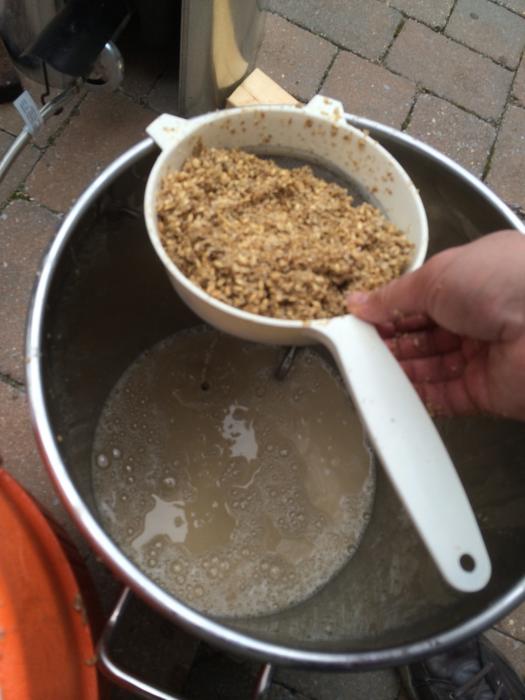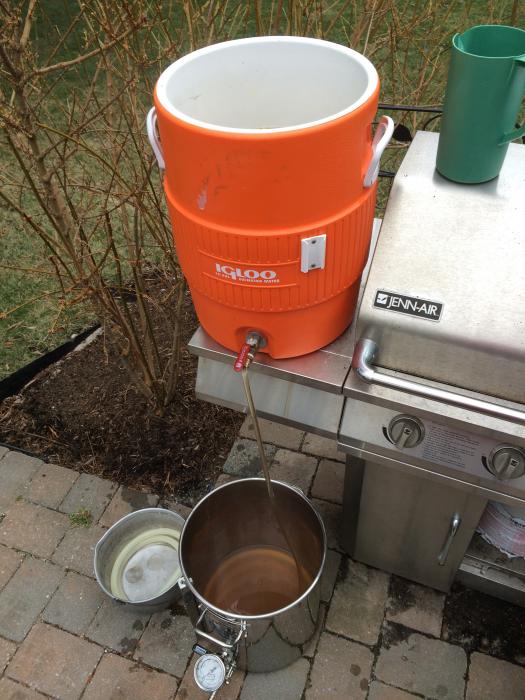So today I finally got to use the ECY01 yeast that I bought back in the fall - for a turbid mash, lambic-style sour (that I'm going to call lambeec - if you know me you know I hammer the bee theme home whenever and where ever possible!)
First off I have to give a big tip of the hat and huge thank you to TNGabe! His brew on this in the fall got me interested in doing one in the first place and he was kind enough to share his experience and give me pointers as I planned my own.
I started a little later than I originally planned (mostly because today was a holiday for me and I wanted to sleep in!) I started pulling out my equipment and setting up around nine, lit the burner for strike water a little after 10 and did my dough-in around 11. Doing a turbid mash is not for the impatient or feint of heart. It is a multi-step decoction mash (six steps from dough-in until the batch sparge I did) and it takes time and a lot of attention to detail.
The recipe was the easy part - 8 pounds pilsner malt with 5.5 pounds of unmalted wheat. Doesn't get much simpler than that.
For the dough-in I hit with water that was too hot and by the time I brought the temperature down for an acid rest (around 113 F) I was worried that I started to denature the alpha amalayse and kill the mash before it really even started (luckily this was not the case.)
[see 1st picture]
After getting the temp under control and letting it sit for 15 minutes, I added boiling water to bring it up to 0.8 quarts of water per pound of grain and give it a 15 minute protein rest. After that I went through multiple attempts at extracting wort from the tun as I could. My original plan failed as the strainer I was going to use wouldn't fit in the tun. After a couple of failed starts I just scooped out the wet grains into a strainer and pressed with my hand to extract the wort (very milky in appearance from all the starch) into the kettle.
[see second picture]
I heated that on the grill while I added 0.6 qt/pound water to do the sacharification rest. At the end of that I vorlaufed as usual and drained as much from the tun into the kettle as I could (and put that back on the grill to hold at 190 F)
[see third picture]
Then I added another 0.6 qt/pound boiling water for a dextrinization rest before vorlaufing, draining the tun and heating all the collected wort to 190 F. Once the collected wort all hit 190 it went back into the tun, stirred like crazy, vorlaufed and collected back into the kettle. That went onto the burner to start heating while i did a batch sparge with 190 F water and adding those runnings into the kettle as well - all for a total of 8.9 gallons at the start of boil.
The day started off very nicely - in the upper 40's and calm, but as the day went on the wind kicked up. Enough so that I needed to throw together a ghetto wind shield to keep the burner working efficiently.
[see fourth picture]
Lambic-style boils typically go three to four hours, but the one advantage of cold windy air moving in was that the boil-off rate went through the roof. I was seeing about 1 gallon every 30 minutes which sped up the boil process for me big time. With about twenty minutes to go I added the first ounce of 18-month old fuggle hops that I'd had sitting out several days to oxidize. Ten minutes later I added two more ounces (whole hops) to bring the wort up to about 10 IBU. The cold winter so far helped out with cooling the wort down - it went from boil to 70 F in about 15 minutes!
After that it was a matter of transferring to the fermenter and pitching my ECY-01 yeast (while enjoying a brew, of course!)
[see fifth picture.]
So Beersmith predicted a pre-boil gravity of 1.041 and I hit that right on the money (which after the high start to temperature on the dough-in really surprised me.) The post-boil gravity was predicted at 1.054 and I hit 1.057 (a bit high for lambic-style, but I'll take it!)
All in all this was a long, challenging and fun brew day. Can't recommend every homebrewer try a turbid mash at some point (just get an earlier start - it was a little after 7 when I finished cleaning, so a 10 hour brew day all told.) Now to let this brew take its time to ferment and age. I'm sure I will do this every year so that in three years I can actually blend a batch that I'll be happy to bottle and share!





First off I have to give a big tip of the hat and huge thank you to TNGabe! His brew on this in the fall got me interested in doing one in the first place and he was kind enough to share his experience and give me pointers as I planned my own.
I started a little later than I originally planned (mostly because today was a holiday for me and I wanted to sleep in!) I started pulling out my equipment and setting up around nine, lit the burner for strike water a little after 10 and did my dough-in around 11. Doing a turbid mash is not for the impatient or feint of heart. It is a multi-step decoction mash (six steps from dough-in until the batch sparge I did) and it takes time and a lot of attention to detail.
The recipe was the easy part - 8 pounds pilsner malt with 5.5 pounds of unmalted wheat. Doesn't get much simpler than that.
For the dough-in I hit with water that was too hot and by the time I brought the temperature down for an acid rest (around 113 F) I was worried that I started to denature the alpha amalayse and kill the mash before it really even started (luckily this was not the case.)
[see 1st picture]
After getting the temp under control and letting it sit for 15 minutes, I added boiling water to bring it up to 0.8 quarts of water per pound of grain and give it a 15 minute protein rest. After that I went through multiple attempts at extracting wort from the tun as I could. My original plan failed as the strainer I was going to use wouldn't fit in the tun. After a couple of failed starts I just scooped out the wet grains into a strainer and pressed with my hand to extract the wort (very milky in appearance from all the starch) into the kettle.
[see second picture]
I heated that on the grill while I added 0.6 qt/pound water to do the sacharification rest. At the end of that I vorlaufed as usual and drained as much from the tun into the kettle as I could (and put that back on the grill to hold at 190 F)
[see third picture]
Then I added another 0.6 qt/pound boiling water for a dextrinization rest before vorlaufing, draining the tun and heating all the collected wort to 190 F. Once the collected wort all hit 190 it went back into the tun, stirred like crazy, vorlaufed and collected back into the kettle. That went onto the burner to start heating while i did a batch sparge with 190 F water and adding those runnings into the kettle as well - all for a total of 8.9 gallons at the start of boil.
The day started off very nicely - in the upper 40's and calm, but as the day went on the wind kicked up. Enough so that I needed to throw together a ghetto wind shield to keep the burner working efficiently.
[see fourth picture]
Lambic-style boils typically go three to four hours, but the one advantage of cold windy air moving in was that the boil-off rate went through the roof. I was seeing about 1 gallon every 30 minutes which sped up the boil process for me big time. With about twenty minutes to go I added the first ounce of 18-month old fuggle hops that I'd had sitting out several days to oxidize. Ten minutes later I added two more ounces (whole hops) to bring the wort up to about 10 IBU. The cold winter so far helped out with cooling the wort down - it went from boil to 70 F in about 15 minutes!
After that it was a matter of transferring to the fermenter and pitching my ECY-01 yeast (while enjoying a brew, of course!)
[see fifth picture.]
So Beersmith predicted a pre-boil gravity of 1.041 and I hit that right on the money (which after the high start to temperature on the dough-in really surprised me.) The post-boil gravity was predicted at 1.054 and I hit 1.057 (a bit high for lambic-style, but I'll take it!)
All in all this was a long, challenging and fun brew day. Can't recommend every homebrewer try a turbid mash at some point (just get an earlier start - it was a little after 7 when I finished cleaning, so a 10 hour brew day all told.) Now to let this brew take its time to ferment and age. I'm sure I will do this every year so that in three years I can actually blend a batch that I'll be happy to bottle and share!







